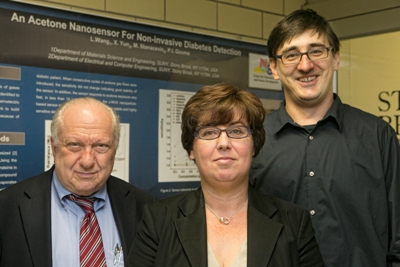Oct 4 2012
An interdisciplinary team of Stony Brook University researchers have been selected to receive a three year National Science Foundation (NSF) award for the development of a personalized asthma monitor that uses nanotechnology to detect known airway inflammation biomarkers in the breath. The project, “Personalized Asthma Monitor Detecting Nitric Oxide in Breath,” comes with a $599,763 award funded through August 31, 2015.
 Stony Brook University researchers (from left to right) Sanford Simon, Perena Gouma and Milutin Stanacevic received a three year National Science Foundation grant for $599,763 to develop a personalized asthma monitor to detect and measure nitric oxide in breath.
Stony Brook University researchers (from left to right) Sanford Simon, Perena Gouma and Milutin Stanacevic received a three year National Science Foundation grant for $599,763 to develop a personalized asthma monitor to detect and measure nitric oxide in breath.
The researchers, led by Perena Gouma, PhD, Professor in the Department of Materials Science and Engineering and Director of the Center for Nanomaterials and Sensor Development at Stony Brook, and her research collaborators, Milutin Stanacevic, PhD, Associate Professor, Department of Electrical and Computer Engineering; and Sanford Simon, PhD, Professor, Departments of Biochemistry and Cell Biology and Pathology; are developing a nanosensor-based microsystem that captures, quantifies, and displays an accurate measure of the nitric oxide concentration in a single-exhaled breath.
Through the Smart Health and Wellbeing Program under which this grant was issued, the NSF seeks to address fundamental technical and scientific issues that support much needed transformation of healthcare from reactive and hospital-centered to preventive, proactive, evidence-based, person-centered and focused on wellbeing rather than disease. This is a Type I: Exploratory Project, which means that it will investigate the proof-of-concept or feasibility of a novel technology, including processes and approaches that promote smart health and wellbeing.
“We are very excited about the NSF’s support of our research, which will enable us to make the leap from breath-gas testing devices to actual breath-test diagnostics for asthma and other airway diseases,” said Professor Gouma. “Our team brings together multidisciplinary expertise that spans the science, engineering and medical fields and aims to use the latest nanotechnologies to provide the public with affordable, personalized, non-invasive, nitric oxide breath diagnostic devices.”
According to Professor Gouma, the technology studied in this project provides an effective and practical means to quantitate nitric oxide levels in breath in a relatively simple and noninvasive way – detecting fractional exhaled nitric oxide, a known biomarker for measuring airway inflammation. “The device will be especially suitable for use by a wide range of compromised individuals, such as the elderly, young children and otherwise incapacitated patients,” she added.
Since 2002, Professor Gouma has received funding from the NSF to develop sensor nanotechnologies for medical applications. In 2003, she received an NSF NIRT (Nanoscale Interdisciplinary Research Team) award, which helped to establish the Center for Nanomaterials and Sensor Development. Professor Gouma’s research has been featured by the NSF Science Nation and has been widely publicized in the media, including Fox News’ Sunday Housecall; Scientific American; Personalized Medicine; Women’s Health and more. She is a Fulbright Scholar, serves as an Associate Editor of IEEE Sensors Journal and the Journal of the American Ceramic Society.